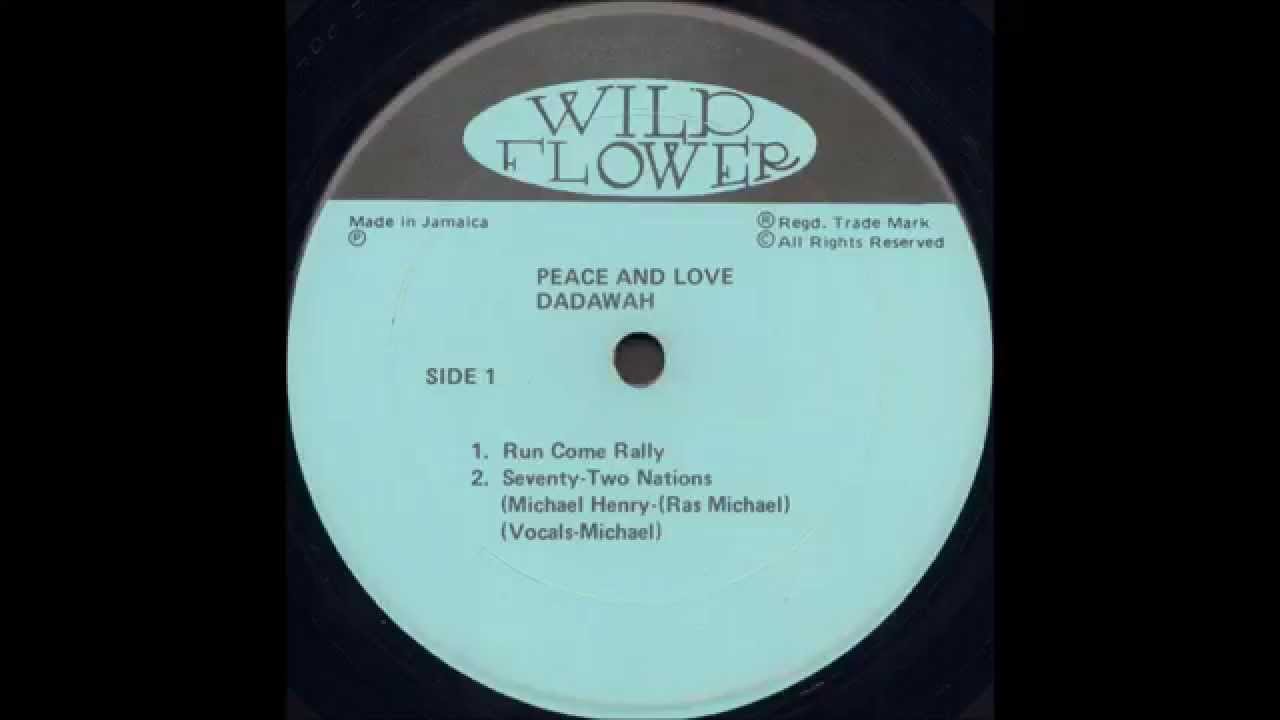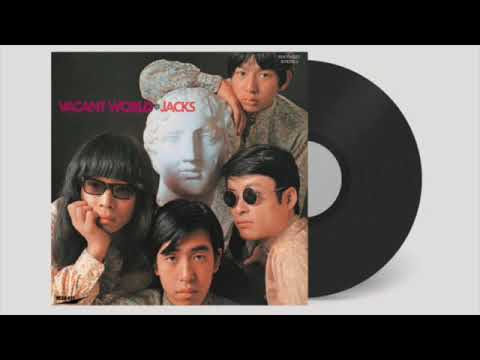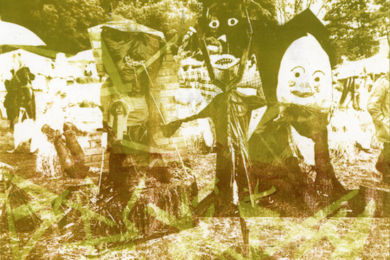59.
Diskonnected is one of the main heads behind Taiwan-based record label and mix series Smoke Machine, as well as the annual techno festival Organik. On this mix for the blog Truants, he wanted to “showcase [his] musical development over the previous two years” amid the extended COVID-19 shutdown that had taken place in his native country, he said. Having gone deeper into digging unheard and forgotten gems from the ’90s, and subsequently purchasing various records, via Discogs during the downtime, this set gave him an opportunity to share some of his discoveries. Loaded with patient, fluid blends, it’s a mix that lets the track selection do much of the talking as the DJ rolls through starry Detroit techno, early ’90s house cuts and deep 4×4 rollers.DiskonnectedTruancy Volume 294N/A
58.
As the title suggests, this compilation initially sold at this past summer’s End Of The Road festival is a collection of some of the songs that founder Simon Taffe likes to play over the PA during the changeover between acts on the main stage. This is not, however, simply a record of ‘songs Taffe likes’ – it is clear that there’s nuanced curation behind the double LP package, whether it’s in the way Captain Beefheart’s ‘Observatory Crest’ sweeps into Link Wray’s ‘Fallin’ Rain’ to evoke that not unpleasant festival morning melancholy, or the blissfully soulful closing run of Sam Cooke’s ‘Jesus Gave Me Water’ into Paul Robeson’s ‘Lazy Bones’, through The Cryin Shames’ ‘Please Stay’ that conjures that feeling of contentment to be found only in a distant field. Playing it while nursing a comedown when I returned home the Monday after this that year’s event, it felt like I could feel beams of Saturday afternoon sunshine returning over the horizon.Various ArtistsEnd Of The Road Presents: Between The MusicEnd Of The Road
57.
All hail a new album of previously unreleased album of recordings by Emahoy Tsegué-Maryam Guèbrou. There’s never been quite enough Emahoy, and notably, this album trails one arriving next year that will be a whole album of her singing. As well as hearing her voice here, Jerusalem also contains home recordings and hard to find tracks from her 1972 album Hymn Of Jerusalem. Some of the pieces here open up a style with less spiritual weight than the well-loved tracks from releases like Spielt Eigen Kompositionen but it remains incredibly distinctive – she moves around the keys with a skipping gait that is all her own, and which is complimented by the way her compositions tend to pause-and-tumble… pause-and-tumble. She makes some of the most beautiful music ever made. Emahoy TseguMaryam GubroupJerusalemMississippi
56.
This epochal psychedelic dub record by Jamaican vocalist and drummer Ras Michael and his band of veteran studio musicians Dadawah, which reflects on spiritual enlightenment, rastafarianism, Biblical themes, Black unity and social struggle, is an unparalleled ’70s classic. A shining example of dub post-production ingenuity, it boasts an ethereal sound grounded by ceremonial Rasta nyabinghi drums, sublime rock and blues-indebted guitar riffs intertwining with hazy piano licks and polyphonous devotional chants.DadawahPeace & Love: WadadasowAntarctica Starts Here
55.
One thing you learn flogging records is, some albums sell themselves. All you’ve gotta do is put them out on the shelf. Maybe the artist behind it has a certain broad, obvious appeal, or conversely, maybe they don’t. And maybe that’s a good thing. These records are niche prospects, but are, crucially, by artists who’ve found their niche – and their comparatively small but dedicated fanbase. These are records that, while maybe not printed up in the hundreds of thousands – or even in the thousands – nevertheless sell. The fans emerge from the woodwork, feelers twitching. Long-running San Francisco noise-blues malcontents Oxbow are one of those niche acts. Octogenarian saviour of skronk, hero of honk, jazz saxophonist-slash-clarinetist Peter Brötzmann is another. So, I suppose it goes without saying that An Eternal Reminder Of Not Today: Live At Moers – an extraordinary document of a fruitful collision between Oxbow and Brötzmann at the Moers Festival in 2018 – is probably one of those LPs that sells itself.OxbowAn Eternal Reminder Of Not TodayTrost Records / Sleeping Giant Glossolalia
54.
Two days ago, I mentioned Oliver Coates’ score for The Stranger and my partner said:”Oh god, I was by myself working in the archives stacks listening to that record and it was freaking me out! Someone walked down the hall and I was so keyed-up that she scared me half to death!” Ominous, mournful, and elegant, Coates’ minimal, intensely atmospheric accompaniment to the year’s most haunting film is powerful enough to transform even the most mundane workplace into something like the grim underpass that inspired it. Masterful stuff.Oliver CoatesThe Stranger OSTLakeshore
53.
Station ’70: Call In Question / Live Independence collects two manic live sessions from the titular year previously issued on CD by P.S.F.. This new edition collects that music with one bonus track on three slabs of high-quality vinyl, packaged in a sturdy box. The furious din the guitarist kicks up with drummer Sabu Toyozumi and bassist Motoharu Yoshizawa — and, on one track, saxophonist Mototeru Takagi — remains astonishing, unveiling not only unparalleled freedom, but a reserve energy that can match anything. This new iteration includes one scalding previously unreleased gem from the original sessions.Masayuki TakayanagiStation 70: Call in Question / Live IndependenceBlack Editions
52.
La NoviaRain Be For Rain BoStandard In-Fi
51.
Following its feted 2015 vinyl compilation of Patrick Cowley’s gay porn soundtracks, Muscle Up, Dark Entries once again taken a trip to the sleazy side for this new LP. This time the label’s focus turns to the pioneering Man Parrish, and his hypnotic, steamy soundtrack to 1982 bathhouse fantasy Turned On.Forbidden OvertureTurned OnDark Entries
50.
Words & Music, May 1965 has the bittersweet taste of what feels like endless possibilities but which we know now, viewing from the other side of history, is always inevitably finite. These songs hint at how clumsy, depraved and glorious life and art can get. And yet they sound so young on these demos. You are hearing Lou Reed before he became Lou Reed, and John Cale before he became John Cale. You are hearing them before they did us the blessing of opening Pandora’s Box.Lou ReedWords & Music, May 1965Light In The Attic
49.
Legendary pianist, DJ and composer Pat Thomas originally dropped this wild jungle album in 1997 before Feedback Moves’ reissue this year introduced it to a wider audience with a firs-time vinyl pressing. Lightyears ahead of the tasteful jazz-inflected drum & bass of the era, Remembering: New Jazz Jungle is a riot of free jazz, Webernian tone rows, Amen breaks and Sun Ra samples. Why is this album not in your life yet?Pat ThomasNew Jazz Jungle: RememberingFeedback Moves
48.
Jacks have described themselves as “outsiders from the folk-rock jamboree” of the 1960s, but that sounds like a far more light entertainment prospect than they ever were. Vacant World is a radical, existential shot of psychedelic dirge and despair that prefigured so much that came later. It was high time it got a full reissue, as there’s nothing rawer than the opener, ‘Marianne’, on which long-haired singer Yoshio Hayakawa tells of being possessed by the siren Marianne who drags him into the murky depths. “Nihilist doom folk in advance of the third Velvet Underground album,” said Julian Cope. Essential!JacksVacant WorldMesh-Key
47.
On their contribution to the Air Texture compilation series, Anthony Naples and DJ Python place the focus on the scene that has sprung up around venues like Nowadays, Bossa Nova Civic Club and Elsewhere in their home city of New York. Their two low-slung, low-tempo collaborations, ‘Entouré’ and ‘Final Speaking’, are both highlights, as is the chugging, groovy techno of Aurora Halal and DJ G.’s link-up, ‘Off The Top’. Moving away from New York, Parris’ ‘springtime flows in three ways’ is one of his brightest moments on record to date, and Bitter Babe and Nick León fly the flag for Miami’s burgeoning scene of percussive club music technicians with ‘Ecotone’.Anthony Naples DJ PythonAir Texture VIIIAir Texture
46.
In the 1980s and ’90s, before Silicon Valley found the cybernetic sea legs it will soon use to crush us under its feet, you could still be a poor person and make art in San Francisco. As such, it had a vibrant and dedicated freak scene. The 1960s Haight-Ashbury dream may have died a brutal, stumbling death, and the city was downtrodden, but it also had a crackling energy, broad social tolerance, and very affordable rents. Think Fellers Union Local 282 were able to follow a bizarre, uncommercial muse in what has since become one of the most economically uninhabitable cities in the United States.Thinking Fellers Union Local 282Strangers From The UniverseBulbous Monocle
45.
Aska Matsumiya Ryuichi SakamotoAfter YangMilan
44.
These tapes – especially the shows of late 1982 – reveal a band that know they’re in a magical place. It can be heard in the reworking of their earlier work, the machine press thuds of ‘The American’ and ‘Sweat In Bullet’ becoming stretched and funky, playful and cavalier. It can also be heard in the way Jim Kerr adlibs and emotes throughout the tour: we note that “Life goes…. So fucking fast!” on ‘Hunter And The Hunted’ at the Leicester de Montfort Hall show, as if Kerr senses but can’t fully comprehend the sheer power of the whole. These things are sometimes uncool for sure, but the band speak in tongues and take their audience with them, oblivious to everything but capturing that moment.Simple MindsNew Gold Dream (81-82-83-84)Virgin
43.
This 15th anniversary reissue invites us to look back at what was not only Dinosaur Jr.’s first album in a decade, but their first to feature the original lineup of the band’s golden late-’80s era. If not quite reaching the peaks of that first phase, it came pretty damn close, and set the stage for one of alternative music’s most impressive second winds.Dinosaur Jr.BeyondBaked Goods
42.
ZULI’s contribution to Dekmantel’s podcast series charts a head-spinning path through hard-hitting percussion, twisted dancehall-esque rhythms, metal and gabber-influenced club music, noise, weightless grime and plenty other idiosyncratic electronic sounds. It proves his DJ sets are every bit as creative and enthralling as his records for labels like UIQ and Haunter.ZULIDekmantel Podcast 409N/A
41.
This is the first-ever release of an 84-minute-long drone work by TEM-affiliate Terry Jennings, composed in 1960, arranged in just intonation by La Monte Young, and performed by legendary cellist Charles Curtis in 2016. There are very few recordings of Jennings’ work out there, and what there is, is for piano, so this would be an important release even if it wasn’t completely brilliant. While Jennings’ piano work resembles Denis Johnson’s compositions, this piece feels more like an extension of the recordings Saltern released of cellist Charles Curtis’ work. In terms of its place in minimalism, this piece is not like TEM, nor is it as caustic as Conrad. Also, there is no saxophone on it, despite the title. It is, however, a shifting sand dune of strings in slow motion, anchored by a tanpura-like drone and clearly influenced by Indian classical music.Terry Jennings, Charles CurtisPiece For Cello And SaxophoneSaltern
40.
Focusing on razor-edged techno pop, bleepy drum machine minimalism and homemade synth experiments, ’80s Underground Cassette Culture: Volume 2 takes a global view of the ’80s tape underground. Die Achse’s ‘Under The Church’ is a jangly dirge something like The Velvet Underground playing through Echo & The Bunnymen’s effects rig. M Rendell’s ‘CV In”s fragmenting beats are a handmade prefiguring of AI composition. Sluik and Years On Earth’s tracks are machine-cranked diatribes, a pair of bedroom Schopenhauers facing the sheer weight of being.Various Artists’80s Underground Cassette Culture: Volume 2Contort Yourself




